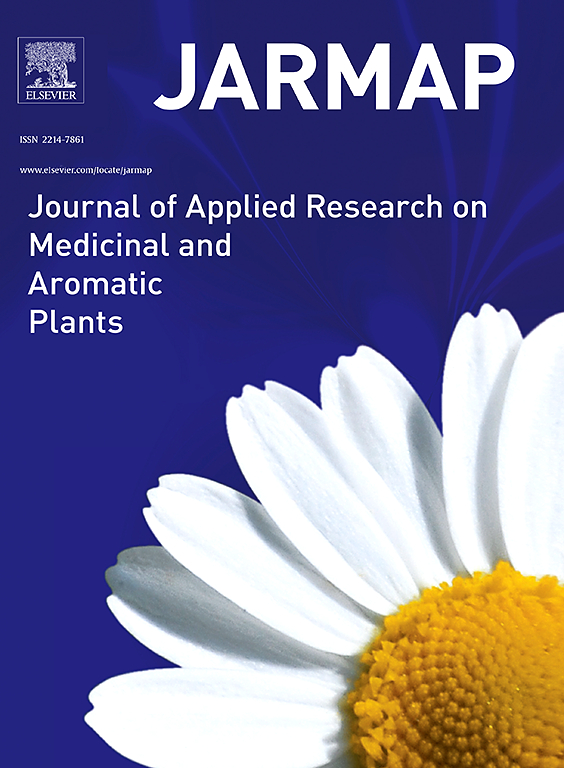栽培白桦木条的农艺实践与挑战综述
IF 3.6
2区 农林科学
Q1 PLANT SCIENCES
Journal of Applied Research on Medicinal and Aromatic Plants
Pub Date : 2025-09-01
DOI:10.1016/j.jarmap.2025.100661
引用次数: 0
摘要
白桦针叶灌木(Agathosma betulina, p.j.b bergius) Pillans,俗称buchu,是南非开普区特有的一种具有重要药用和商业价值的灌木。尽管其精油因富含二酚和硫化合物而受到重视,但种植仍然受到农艺挑战的限制,继续依赖于不可持续的野生收获。本文从科学数据库和生态上相似的水杨种的资料,综述了水杨的生态适应性、繁殖问题和栽培限制等方面的研究现状。Buchu在酸性(pH值4.0-6.5)、营养贫乏的土壤中茁壮成长。然而,驯化受到种子发芽率低、移植成活率差(<10 %)和栽培植物中精油分布不一致的限制。这些挑战在其原生范围之外加剧,在那里建立不良和对疫霉等根病原体的易感性严重限制了迁地栽培。传统的繁殖(种子、插枝)是不可靠的,而微繁殖虽然有希望,但需要优化以保持生物活性化合物的完整性。采收后的知识差距仍然存在,特别是在采收时间(以减少有毒的pulegoone),干燥和储存。新兴的解决方案包括种子启动、微生物接种剂(例如,劳伦隐球菌)和精准农业技术。将传统做法与创新技术相结合,可以解决繁殖和产量方面的挑战。然而,迫切需要在繁殖和土壤管理方面取得进展,这对这种具有重要文化和生态意义的物种的可持续商业化和保护至关重要。本文章由计算机程序翻译,如有差异,请以英文原文为准。
Agronomic practices and challenges in cultivating Agathosma betulina (P.J.Bergius) Pillans: A review
Agathosma betulina (P.J.Bergius) Pillans, commonly known as buchu, is a medicinally and commercially important shrub endemic to South Africa’s Cape Floristic Region. Although valued for its essential oils rich in diosphenol and sulfur compounds, cultivation remains limited by agronomic challenges, sustaining reliance on unsustainable wild harvesting. This review synthesizes current research on buchu’s ecological adaptations, propagation issues, and cultivation constraints, drawing from scientific databases and ecologically similar fynbos species. Buchu thrives in acidic (pH 4.0–6.5), nutrient-poor soils. However, domestication is limited by low seed germination, poor transplant survival (<10 %), and inconsistent essential oil profiles in cultivated plants. These challenges intensify outside its native range, where poor establishment and susceptibility to root pathogens like Phytophthora spp. severely limit ex situ cultivation. Conventional propagation (seeds, cuttings) is unreliable, while micropropagation, though promising, requires optimization to preserve bioactive compound integrity. Postharvest knowledge gaps persist, especially in harvesting timing (to reduce toxic pulegone), drying, and storage. Emerging solutions include seed priming, microbial inoculants (e.g., Cryptococcus laurentii), and precision agriculture techniques. Bridging traditional practices with innovative technologies may address propagation and yield challenges. However, urgent advances in propagation and soil management are vital for sustainable commercialization and conservation of this culturally and ecologically significant species.
求助全文
通过发布文献求助,成功后即可免费获取论文全文。
去求助
来源期刊

Journal of Applied Research on Medicinal and Aromatic Plants
Pharmacology, Toxicology and Pharmaceutics-Drug Discovery
CiteScore
6.40
自引率
7.70%
发文量
80
审稿时长
41 days
期刊介绍:
JARMAP is a peer reviewed and multidisciplinary communication platform, covering all aspects of the raw material supply chain of medicinal and aromatic plants. JARMAP aims to improve production of tailor made commodities by addressing the various requirements of manufacturers of herbal medicines, herbal teas, seasoning herbs, food and feed supplements and cosmetics. JARMAP covers research on genetic resources, breeding, wild-collection, domestication, propagation, cultivation, phytopathology and plant protection, mechanization, conservation, processing, quality assurance, analytics and economics. JARMAP publishes reviews, original research articles and short communications related to research.
 求助内容:
求助内容: 应助结果提醒方式:
应助结果提醒方式:


